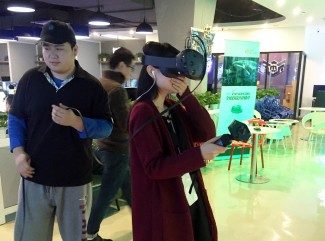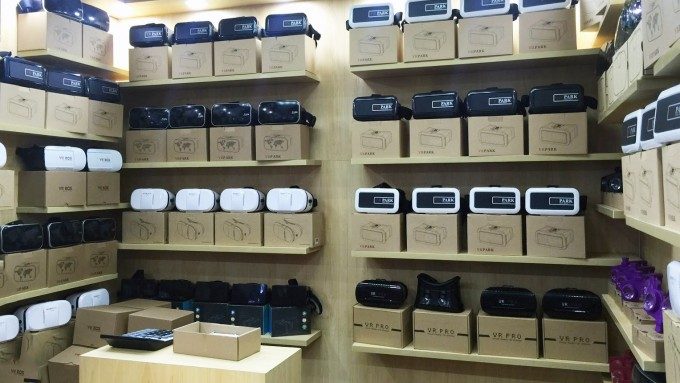Over the last three years, the rise of VR in public discourse has been impossible to ignore. During this time, most mainstream discussions have centered on the same few efforts in the US : Oculus, Valve/HTC, Sony, Samsung, and Google. But there’s something just as important going on roughly 7,000 miles west of San Francisco.
Guest article by Anjney Midha:


Across the Pacific Ocean in Shenzhen, China, in the markets of Huaqiangbei, the factories in Dongguan, and in the high rise offices of Nanshan, is where demand and supply for VR hardware and software are on par, if not outpacing, the US. The Edge team took a few days to go on the ground in Shenzhen in March, and this is a summary of what we saw.


If you, like us, believe that VR has a bright future, then you likely believe in the ability of most people on Earth to access mobile VR. This is because smartphones are the only devices that have anywhere near the scale, computational ability, and price points to bring VR to most of the planet in the near future. This is the story playing out in Shenzhen. Unlike the Rift and Vive, which cost around $1,600 all-in for headset and PC, there are a hundred different flowers of mobile VR blooming (pun intended) in the Chinese electronics market, ranging from low tech VR smartphone cases to standalone Android headsets. Not all of these are strictly VR devices (we’ll get into that in a moment), but when it comes to stereoscopic, head mounted displays (HMDs) for consumers, Shenzhen is a leader.
Broadly, most devices we saw fell into three categories — Mobile VR headsets, PC HMDs, and standalone headsets.
Mobile VR (a.k.a. Budget VR)
These mobile headsets involve turning your phone into a VR viewer by adding a couple of plastic biconvex lenses to a frame that holds your mobile device, essentially a nicer version of Google Cardboard. The sheer range of these is reminiscent of the explosion in custom smartphone cases since 2010. The bulk of stores we saw dedicated to mobile VR headsets were located in the SEG Communications Market, a multi storey edifice dedicated just to mobile parts and accessories, sold by the sorts of retailers who would otherwise be selling cases, chargers, cables and lens protectors for phones.
The cheapest of these was the $10 VRCase iPhone case viewer below (prices can drop quickly below this with the number of units you buy) similar to the Figment Kickstarter, with the most expensive one at $45 for a drop-in style viewer.
There are entire retail storefronts, like the one pictured below, dedicated just to these mobile VR headsets. While speaking to the folks manning these stores, we were told it’s common to move up to 1,000 headsets a day in retail, and 10k units a day to distributors, with orders mostly from locals or buyers visiting from Korea and Japan.
When we asked the VR salesmen which apps were most popular with consumers in China, we saw a combination of apps from overseas like Homido and Cmoar’s cinema apps, and homegrown first party apps, like Baofeng Mojing and VRCase’s iOS VR players. Watching 2D movies and videos in 3D spaces is by far the most popular use case for these headsets, with gaming and virtual tours as runner ups.
PC-only Headsets (a.k.a High End VR)
Adjacent to the mobile accessories building is the main SEG tower, a 72 story building with 10 floors dedicated to a dizzying range and number of electronics retailers. Here is where we spotted a few Oculus and Rift alternatives, like the AntVR pictured below which offers similar specs to the DK2 for around $280 and comparable build quality, and the Deepoon E2, another DK2 alternative.
The lack of enthusiasm for these compared to the mobile headsets from the retailers was palpable, and it sometimes felt like these headsets were displayed more for novelty value than anything else. This is understandable, given the low volume of these headsets that are moving in the market and their relatively high prices for the average Chinese consumer market.
All-In Headsets
Walking through Huaqiangbei, it became apparent to us that there’s a secondary consequence of the rise of VR taking place — namely, a halo effect on non-VR HMDs. These are essentially stereoscopic media players, which give you the ability to watch your regular 2D content on a display that, when suspended on your face, offers the effect of a much larger screen. While these have been around for years in various form factors and high price points like the $799 Sony HMZ (which launched in 2011) and the $500 Vuzix iWear, we saw a plethora of newer, cheaper alternatives.
We were told these have become popular as HMDs like the GearVR and Oculus are making it more palatable for consumers to strap displays to their faces. Most of these were running their own flavors of Android on the headset, and had USB ports for users to plug in their own content. These ranged from $120 video players, to the $617 RoyoleX headset that offers a direct alternative to devices like the $700 Avegant Glyph. While none of these are VR headsets in the strict sense that they didn’t have gyroscopes and accelerometers to allow head tracking, it seems to be only a matter of time before that changes with the coming launches of devices like the Baofeng Mowang, LeTV’s Helmet, and Pico Neo.
One of the headsets we bought, the Bijela iTheater (pictured), essentially works as a fully functional tablet, allowing you to run all the apps you’d typically want to use with a desktop monitor (Gmail, Chrome, Kindle Reader etc.) but with a mobile device that fits in your backpack, costs you roughly $190 and weighs about 40% less than a GearVR with a phone. It’s easy to see why headsets like these that are somewhere between VR headsets and smartphones both in functionality and price points could become popular with young consumers who have never owned a dedicated PC or laptop.
The Bijela iTheater — one of many non VR HMDs seen in Huaqiangbei
Takeaways
Last year, we wrote about a coming age of mobile VR. Shenzhen is where that future is approaching quickly. It’s an exciting time in history, where for the first time we’re seeing the convergence of two unique trends — massive numbers of smartphones in the hands of billions of people, combined with the sheer range of low cost VR headsets described above. Over the next few years, founders working on compelling software experiences in VR will be able to build for an audience of hundreds of millions of users who can access VR for the price of a low cost smartphone accessory. This is the reason we’re excited to work with entrepreneurs working on building the apps, services and metaverses that will bring these headsets to life for consumers across the world.
If you’re one of these founders, let’s talk!
This article was published originally on the KPCB Edge blog.


